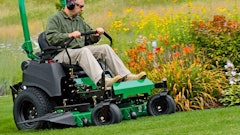
Technology, erratic weather patterns, invasive pests and hyper-competition are affecting tree care contractors just as much as any other type of Green Industry contractor. Experts at the Tree Care Industry Association (TCIA) help us take a look at four key trends that are helping to shape the tree care industry for the next several years.
1. Tech in the Field
It’s the 21st century, and arborists can utilize their phones directly in the field for arboriculture help. One of the newest advancements is the implementation of apps, or small, specialized programs downloaded onto mobile devices.
A recently released industry app is the IPMPro mobile app, which seeks to streamline your pest management decision-making employee training. It’s also designed to send you push notifications when action is needed. Additionally, IPMPro allows electronic recordkeeping of pesticide applications, automatically compiling the records and emailing them to you. Plus, the app provides sample photos of affected host species. (Note: IPMPro only serves the Gulf Coast and Atlantic Seaboard.)
Other apps on the marketplace include:
- Leafsnap (developed by researchers from Columbia University, the University of Maryland and the Smithsonian Institution) uses visual recognition software to identify tree species from photographs of their leaves.
- TreeBook (produced by veteran forester Steve Nix and developed by new media and mobile specialist Ash Mishra, is a guide to 100 of the most common trees in North America.
- Based on Michael A. Dirr’s classic work, "The Manual of Woody Landscape Plants," Dirr's Tree and Shrub Finder covers 1,670 species and 7,800 cultivars with 7,600 plant images. The plant database is searchable by 72 criteria, including hardiness zones, water and light requirements, etc.
As time goes on, more and more arboriculture apps will be developed. Oftentimes they may save contractors time searching the Internet or thumbing through books, though nothing will be able to replace good old-fashioned tree knowledge and experience.
2. Beware of Fakes
This was a summer chock full of stories about homeowners getting ripped off by unprofessional tree care companies.
David Bellavance, director of safety and training at TCIA-member company Tree Tech Inc. based in Foxboro, MA, explains, “Some guys have figured out that they can gain some people's trust by showing up in a pickup truck, putting on a hard hat, and acting like a concerned tree care worker.”
In a profession that is facing more challenges like this, it’s important for both homeowners and tree care professionals to be well-informed. Check out the online feature, "What Makes a Tree Care Pro," for a rundown of common credentials all tree care professionals should have, along with tips on how contractors can promote those credentials to gain a competitive advantage.
3. Emerald Ash Borer
The emerald ash borer (EAB) is a metallic wood-boring beetle from Asia that is considered invasive in the U.S. It has destroyed millions of ash trees. Economic and environmental damage is considerable when this exotic pest invades a new area. It is important how a city or town will prepare for EAB's potential arrival.
A planned management strategy in place before the insect arrives in your area will cost far less than coping with widespread tree death. In addition, important ash trees on public and private property can be treated in advance to help resist the pest pressures.
Contractors can set up an integrated pest management (IPM) plan as one component of an overall plant health care program. This requires monitoring the property long before the pest lands in the area for signs of EAB activity, in addition to using a variety of controls at the proper time of year to best manage the insect.
To keep an eye on the spread of EAB across the U.S., visit emeraldashborer.info/surveyinfo.cfm.
4. Year of the Drought
Drought, or water deficits in trees, cause trees injury, ranging from symptoms of leaf wilting to total plant death.
Wilting of the leaves in hardwood trees can be either temporary or permanent, depending on the length of time water is unavailable. Temporary wilting can be seen as leaves drooping during the day. At night the tree will normally rehydrate and recover. If the tree does not recover during the overnight period, temporary wilting can become permanent. Permanently wilted trees may recover when water is added to the soil, but prolonged permanent wilting usually kills most species of plants.
Conifer trees, especially pine trees, usually don’t "wilt" from drought stress. During very dry periods, the second-year needles (located away from the tips of the branches) will turn yellow and begin to drop from the tree prematurely. This is usually a sign of water-deficit stress. If the needles on a pine tree turn from yellow to red, the tree is severely damaged, and usually dies.
Stressed pine trees may be attacked by pine bark beetles, which are insects that fly to a weakened or stressed pine tree and attack by boring through the bark. They feed and lay their eggs between the bark and the wood.
QUICK TIP – Sometimes, it is tricky to determine if a tree has died from drought stress or has simply become dormant and appears to be dead. Try this simple test to make a determination: Use your fingernail to scrape a small section of bark from a small twig or branch within reach. If the tissue under the bark is green and moist, the tree may still be alive. To be absolutely sure the tree is not dead, wait until the next spring to see if it sprouts a new crop of leaves.
The Tree Care Industry Association (TCIA) is a public and professional resource on trees and arboriculture with more than 2,000 member companies who recognize stringent safety and performance standards and who are required to carry liability insurance. To learn more, visit www.tcia.org.





























